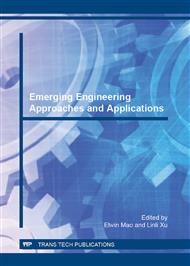[1]
Craig Labovitz, G. Robert Malan, Farnam Jahanian, Internet routing instability, IEEE/ACM Transactions on Networks, Vol. 6, No. 5, October (1998).
DOI: 10.1109/90.731185
Google Scholar
[2]
R. Teixeira and J. Rexford, A Measurement Framework for Pin-Pointing Routing Changes, In Proceedings of ACM SIGCOMM Workshop on Network Troubleshooting, Aug. (2004).
DOI: 10.1145/1016687.1016704
Google Scholar
[3]
D-Fa Chang, R. Govindan, and J. Heidemann, The temporal and topological characteristics of BGP path changes, in Proc. IEEE International Conference on Network Protocols (ICNP), November (2003).
DOI: 10.1109/icnp.2003.1249770
Google Scholar
[4]
M. Caesar, L. Subramanian, and R. Katz. Towards localizing root causes of BGP dynamics, Technical Report UCB/CSD-04-1302, U.C. Berkeley, Nov. (2003).
Google Scholar
[5]
A. Feldmann, O. Maennel, Z. M. Mao, A. Berger, and B. Maggs. Locating Internet routing instabilities, in Proc. ACM SIGCOMM, pages 205–218, Portland, OR, Aug. (2004).
DOI: 10.1145/1030194.1015491
Google Scholar
[6]
M. Lad, A. Nanavati, D. Massey, and L. Zhang, An algorithmic approach to identifying link failures, in Proc. 10th IEEE Pacific Rim International Symposium on Dependable Computing(PRDDC), March 2004, pp.25-34.
DOI: 10.1109/prdc.2004.1276549
Google Scholar
[7]
J. Wu, Z. M. Mao, J. Rexford, and J. Wang, Finding a needle in a haystack: Pinpointing significant BGP routing changes in an IP network, in Proc. Networked Systems Design and Implementation (NSDI), May (2005).
Google Scholar
[8]
M. Lad, R. Oliveira, D. Massey and L. Zhang, Inferring the Origin of Routing Changes using Link Weights, In Proceedings of IEEE ICNP, Oct. (2007).
DOI: 10.1109/icnp.2007.4375840
Google Scholar
[9]
Y. Huang, N. Feamster, A. Lakhina, and J. Xu. Detecting Network Disruptions with Network-Wide Analysis, in Proc. of ACM SIGMETRICS, (2007).
DOI: 10.1145/1269899.1254890
Google Scholar
[10]
T. Ogishi, Y. Hei, S. Ano and T. Hasegawa. Empirical Study on Inferring BGP Routing Instability and its Location based on Single Point Observation, ICC (2007).
DOI: 10.1109/icc.2007.30
Google Scholar
[11]
A. Campisano, L. Cittadini, G. Di Battista, T. Refice, C. Sasso, Tracking Back the Root Cause of a Path Change in Inter-domain Routing, In Proceedings of IEEE/IFIP NOMS, Apr. (2008).
DOI: 10.1109/noms.2008.4575166
Google Scholar
[12]
Wei Liang, Ye Li, Jingping Bi and Guoqiang Zhang. On the Accurate Identification of Familiar Inter-Domain Routing Instabilities, GLOBECOM (2008).
DOI: 10.1109/glocom.2008.ecp.303
Google Scholar
[13]
Kuatse, A.M., Teixeira, R., Feamster, N., and Meulle, M. Joint analysis of network incidents and intradomain routing changes, CNSM 2010, pp.198-205.
DOI: 10.1109/cnsm.2010.5691306
Google Scholar
[14]
M. Watari, A. Tachibana, and S. Ano. Inferring the Origin of Routing Changes based on Preferred Path Changes, PAM (2011).
DOI: 10.1007/978-3-642-19260-9_17
Google Scholar
[15]
R. Oliveira, B. Zhang, D. Pei, L. Zhang, Quantifying Path Exploration in the Internet, IEEE/ACM Transactions on Networking, vol. 17, no. 2, pp.445-458, Apr. (2009).
DOI: 10.1109/tnet.2009.2016390
Google Scholar


